1lumen selects and reviews products personally. We may earn affiliate commissions through our links, which help support our testing.
Klarus XT11GT Pro V2 Review
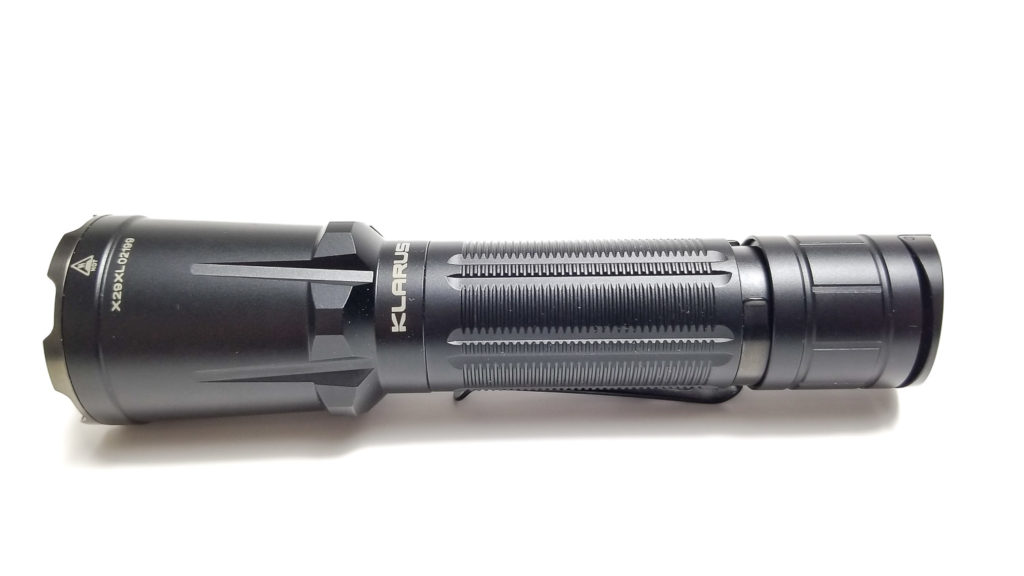
Klarus XT11GT Pro V2 specifications
| Brand/model | Klarus XT11GT Pro V2 |
|---|---|
| Category | Tactical flashlights |
| LED | Luminus SST70 |
| Max. Lumens | 3,300 lm |
| Max. Beam intensity | 29,440 cd |
| Battery config. | 1*18650 or 2*CR123A |
| Onboard charging | USB-C |
| Modes | 4 |
| Blinkies | Strobe, SOS |
| Reflector | Smooth |
| Waterproof | IPX8 |
| Review date | February 2022 |
Introduction:
Klarus (pronounced klar-us) is a brand I don’t hear mentioned very often, and they seem to get lost in the sea of Astroluxes, Lumintops, Convoys, Fenixes, and Acebeams. That’s kind of unfortunate because Klarus has been around for a good long time (since 2011) and makes some nice lights. In case you’re wondering, yep, Klarus is derived from the Latin root clarus, or “clear and bright,” and like other big-name brands, has an expansive product catalog of tactical, EDC, S&R, gear, and accessories a-plenty. As an OEM with their own R&D dept, this sort of elevates them above the average Chinese flashlight company, joining big names like Brinyte, Fenix, Olight, Acebeam, and Sofirn. Fun fact: Klarus claims a bit of stardom as well because their triple reflector RS80 has been featured in a few big-name Hollywood movies (ever see the Mummy?).
Today, I’ll be taking a look at an equally-important light in Klarus’s inventory, the legendary Klarus XT11GT Po V2. This light started out way back in 2013 as the XT11, a dual-switch tactical flashlight targeted towards duty and tactical use. It took the industry by surprise with dual rear switches and (for the time) impressive 1060 Lumen output courtesy of a Cree XM-L2. We all know the matra, if it ain’t broke, don’t fix it, but for flashlights, that goes out the window since companies jockey to keep their inventories up-to-date and competitive. Klarus is no different, continuously improving the XT11 over its lifetime. This new for 2021 Pro V2 version promises a significant bump in output, increased throw, and a UI that appeals to tactical or professional users. I love tactical lights, and I’ve reviewed some of the best on the market so far, so maybe the K11GT Pro V2 will dethrone my go-to choices? Let’s see!
Package quality.
The XT11GT Pro V2 came in a very retail-friendly package. This is common amongst the bigger brands that have the resources and channels for brick-and-mortar retail sales. It has a hangtag with the white and red Klarus color theme with a picture of the light front and center with nice graphics and feature blurbs. I really like the clean, uncluttered layout and it’s a very premium-looking package. The outer box top lifts off and inside, the light was inside the holster sitting in a cardboard holder under a lift-open cover with some preliminary instructions on it. To the right, the accessories are in their own box (like Olight’s accessories). Here’s what you get:
- Klarus XT11GT Pro V2
- Klarus 18GT-IMR31 battery (loaded in the light)
- Lanyard
- Holster
- Spare o-ring
- Manual
- USB A to type C charging cable
Like the competition, Klarus includes everything you need to get going. This is great for a first-time buyer who doesn’t own a charger or li-ion batteries since they don’t have to buy them separately (hint, hint, Acebeam). The accessories are decent quality and nothing special but should give good service. The molded rubber logo on the holster is a nice touch. Only one o-ring? C’mon Klarus. On a $90 light, a single o-ring is a bit cheap.
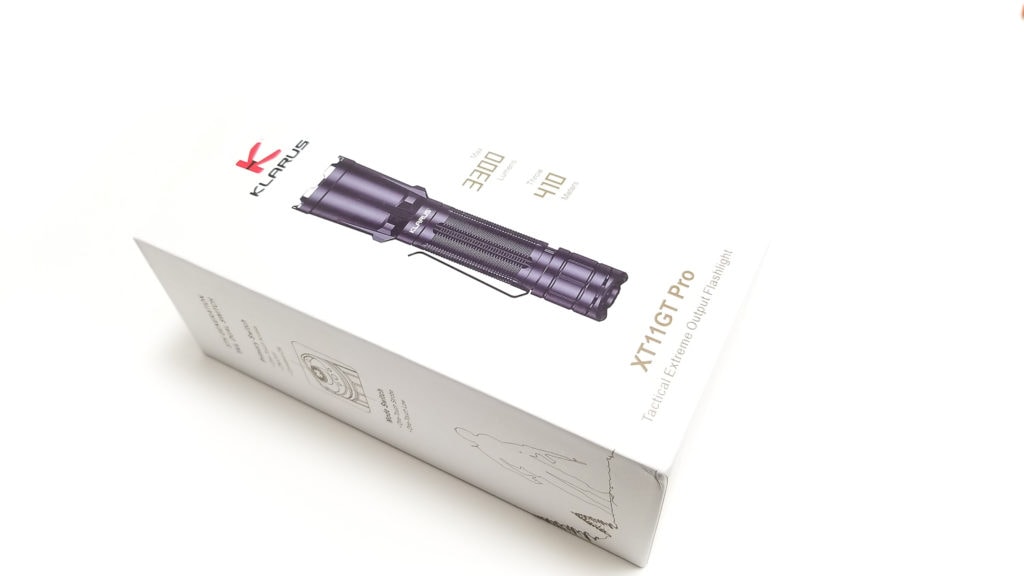
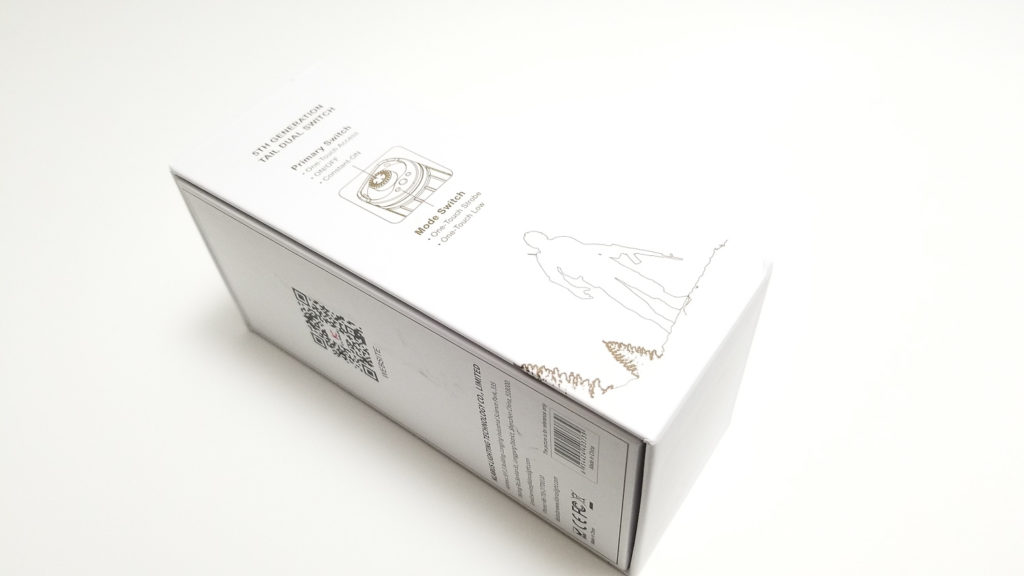
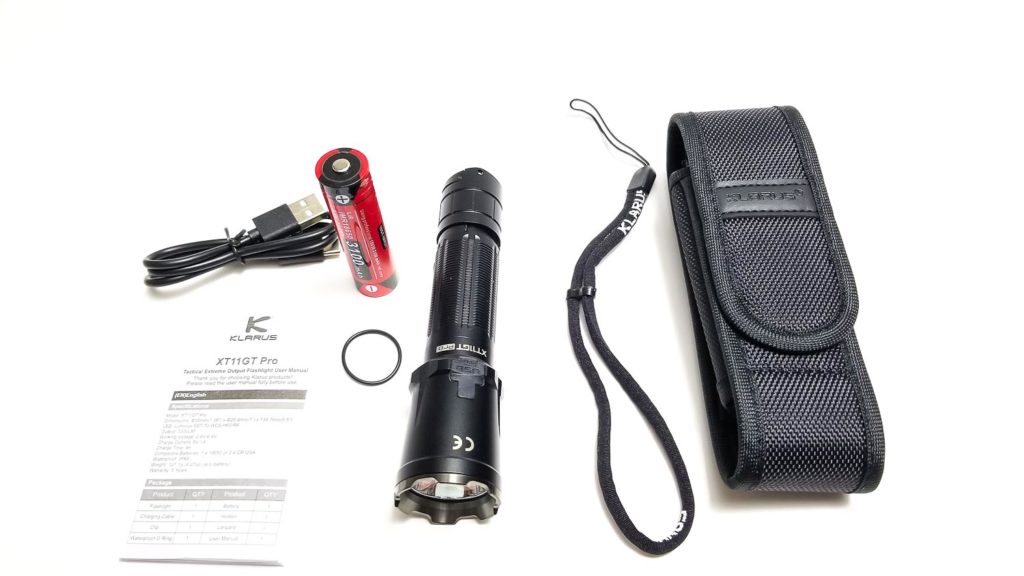
Flashlight in use
The Klarus XT11GT Pro V2 feels and handles similar to a C8 style light. The battery tube is about the same size, but I mainly compared it to the Fenix TK16 V2.0. Although similarly-sized, the XT11GT is an 18650-size light, and the Fenix has a bit more ‘meat’ in the battery tube to grip onto, but I think the Klarus will fit just about every hand size out there. Klarus carried over the Fenix-centric reeding on the battery tube for grip, and I think I like it better than the reeding on the TK16 V2.0. The grooves are a bit thicker and taller and that improved grip quite a lot. The balance is nice and neutral, and all the controls are arranged for easy access. The V2 maintains the original XT11’s switch layout, with a forward clicky for momentary Turbo and large, paddle-like secondary e-switch that comprises half of the tailcap rear face. The forward switch is for switching the light on and off, while the e-switch is for momentary Strobe and mode changes. The switches feel awesome. The forward switch is partially shrouded by the sides of the tailcap, but sticks out just enough to easily manipulate, and it has a nice firm action and positive clicks. The paddle e-switch is positioned directly under the mechanical switch so your thumb naturally rests on it. It’s nicely weighted, so it takes some force to press, which is great since it’s really exposed and this helps prevent unintentional activation. The action is firm with near zero play and sharp, tactile clicks. I could easily activate both switches with the tip and pad of my thumb.
For retention, you get a blackened pocket clip with lanyard attachment points, and a pair of opposed lanyard holes out back. I had issues threading the lanyard though due to the too-small holes, but the pocket clip can be removed without any risk of the light rolling away on a smooth surface thanks to anti-roll features in the head. The USB charge port is positioned on the head, and the rubber cover is contoured to fit seamlessly, so it won’t get hung-up on things. This is one of the better designs for a charge port cover since it’s so unobtrusive. The charge port is flanked by a small LED indicator for charge and battery state. It is not illuminated during operation though. The holster is decent and meant for bezel-up carry with Velcro belt loop and sturdy plastic D-ring. Due to the dual switches, tail standing is not possible, but that’s fine for a tactical/duty light. To go with the extensive tactical feature-set, Klarus offers an impressive selection of accessories for the XT11GT including quick-release duty holsters, diffuser cones, and traffic wands, a nifty tailcap with a 360-degree mode-select ring, extra-aggressive BZ1 strike bezel, FM2 long gun mount, and TRC1 remote switch.
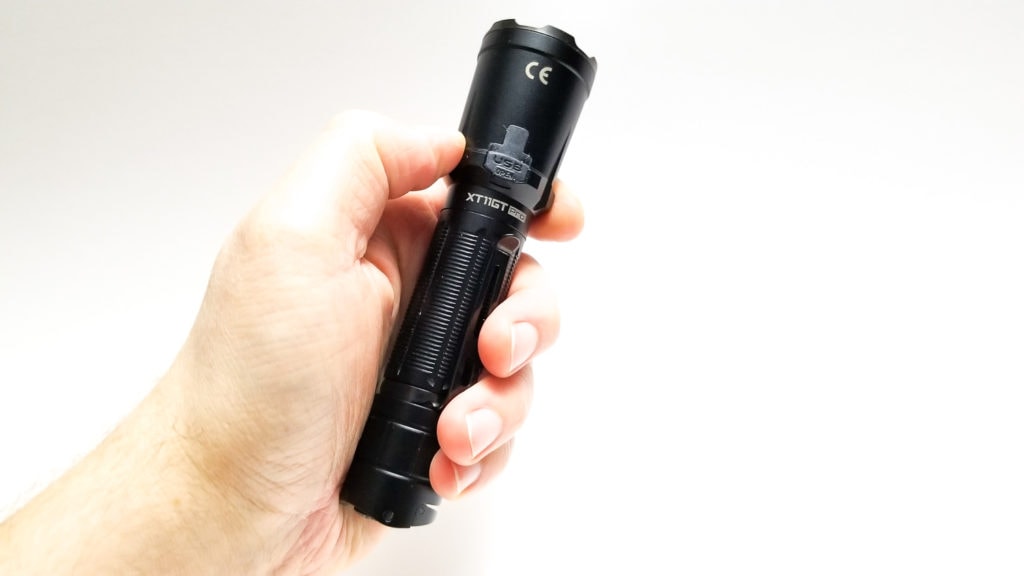
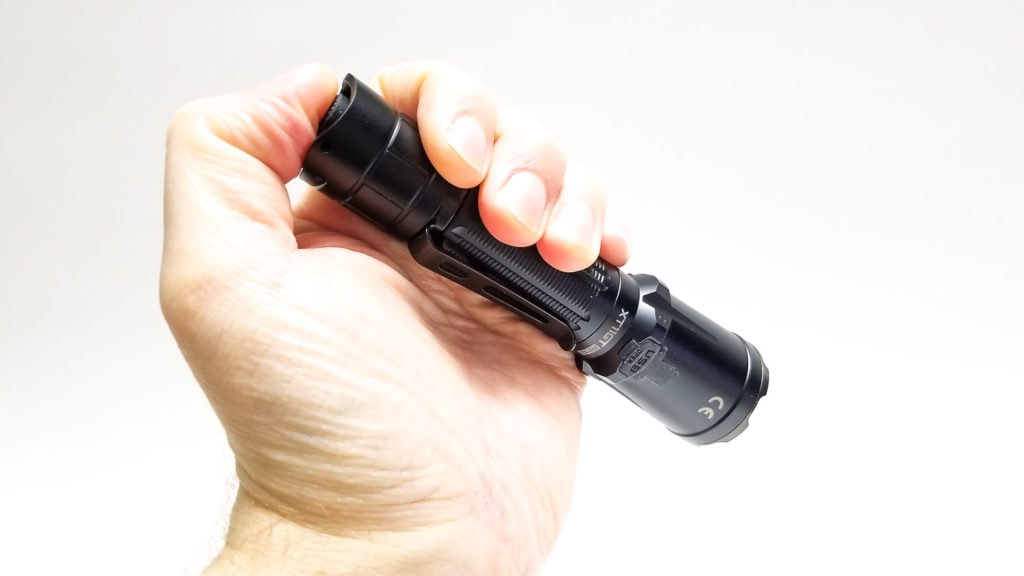
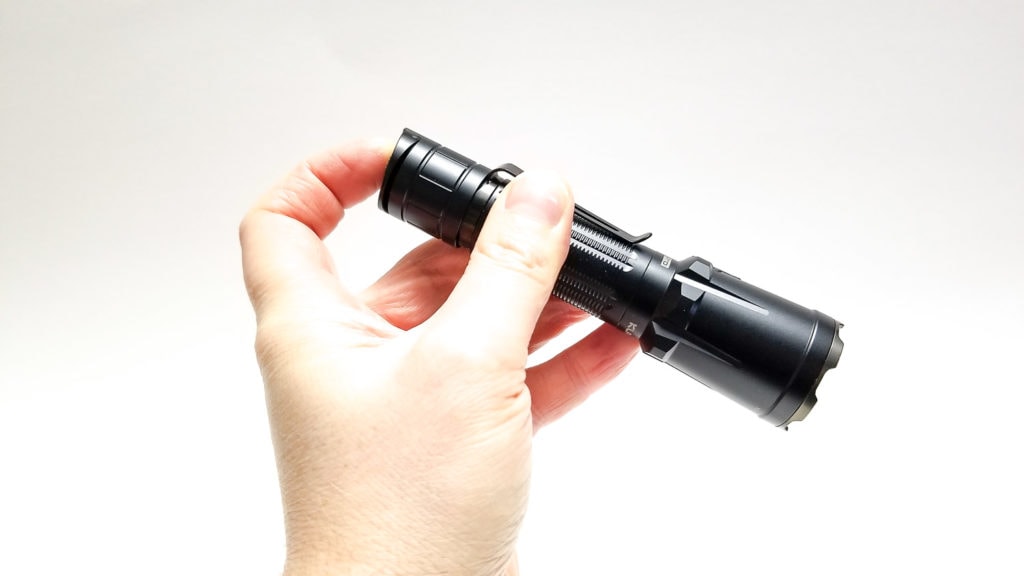

Build Quality, and Warranty
Klarus has a ton of R&D experience, complimented by years of know-how making high-quality flashlights. Klarus lights are positioned alongside Fenix, Speras, Olight, Nitecore, Brinyte, and Acebeam, so these aren’t budget lights. How much? The XT11GT Pro V2 is priced around $90 US, and that’s really a fair price for what you get and competitive with similar offerings from other brands.
The light is constructed from standard 6061-T6 aluminum, and the machining is expectedly very nice. No flaws or obvious tool marks anywhere, and everything fits up perfectly with no obvious gaps. The USB port opening is machined very precisely so the cover fits in flush and snugly, and all the edges are knocked down and nicely chamfered for snag-free handling. The silk screen text is precisely applied and has good contrast. I expect this attention to detail in this price range, but sometimes I find it lacking, so it’s always nice to see a lesser-known company like Klarus taking these steps and attention to detail. The finish is a pretty standard type III hard anodizing in semi-gloss black. For those interested, the technical designation is MIL-A-8625 Type III Class 2 Black 2.0 mil. Ever wonder how that coating gets on there? Put on your thinking tuque and enjoy the show: Anodizing. The finish on the XT11GT Pro V2 is more matte than Fenix’s lights, and while not the most grippy or chalky, it’s very nice and perfectly applied with no thin areas or blemishes anywhere. It seems to be durable as well and I have no doubt it will hold up to use and abuse.
The light passed my “yep, it’s glued” test which is a highly scientific process of me trying to unscrew things with my bare hands whilst making grunting noises. It appears the tailcap guts can be removed as they’re secured by a pair of phillips screws, and the base of the tailcap consists of a large, gold-plated contact with a central spring. The contact interfaces with a captured inner signal tube so the e-switch and mechanical clicky can work together. This is a common design feature on lights using mechanical and e-switches together for mode memory. There’s two gold plated springs at work here, a great feature for a tactical use light since it helps mitigate shock from hard drops (or breaking things), and recoil if mounted to a long gun. Although the springs are a bit small, they are doubled for excellent current-handling and low resistance. Very nice attention to detail! The rear square cut threads are sealed with a single generously sized o-ring. They are super smooth and well lubed out of the box as well. Klarus gives the XT11GT Pro V2 an IPX8 rating for waterproofness, so not the better IP68 rating I’m used to on Acebeam and Fenix, but it should be very waterproof.
Klarus, like the competition, offers a very (even more so) generous warranty. Take it away, Klarus! “KLARUS guarantees the flashlight against defects in material and workmanship. At the discretion of KLARUS, flashlight products that are found to be defective under normal use within 5 years of the proof of purchase date will be repaired or replaced without charge. This warranty does not cover damage caused by accident, misuse or product modification. Any failure of following general user manual instruction could result in damage of your flashlight that may not be covered by KLARUS’ warranty. If the flashlight should prove defective, the product will be repaired or replaced, under the above terms. Please contact KLARUS or your authorized KLARUS retailer for warranty return instructions.”
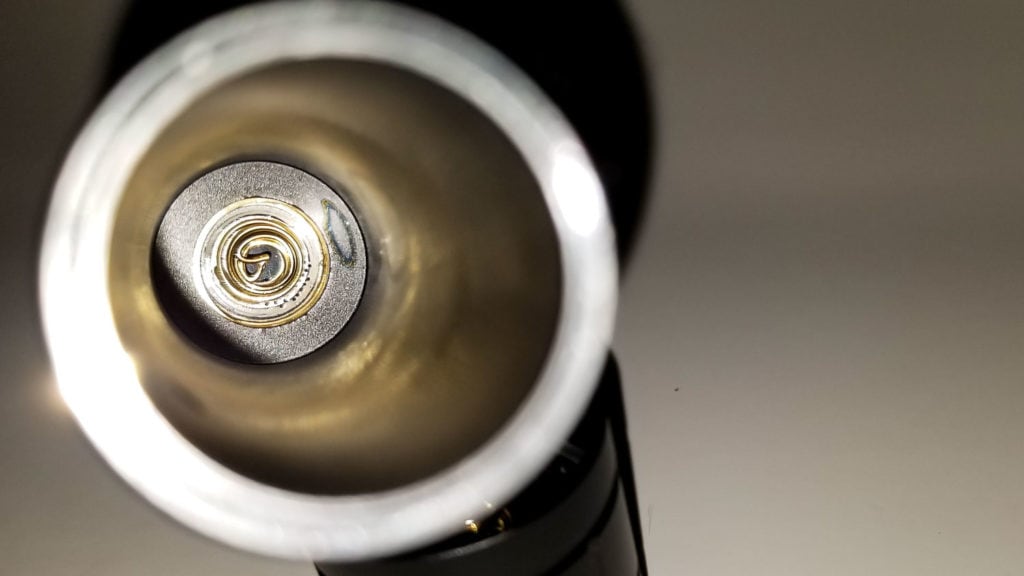
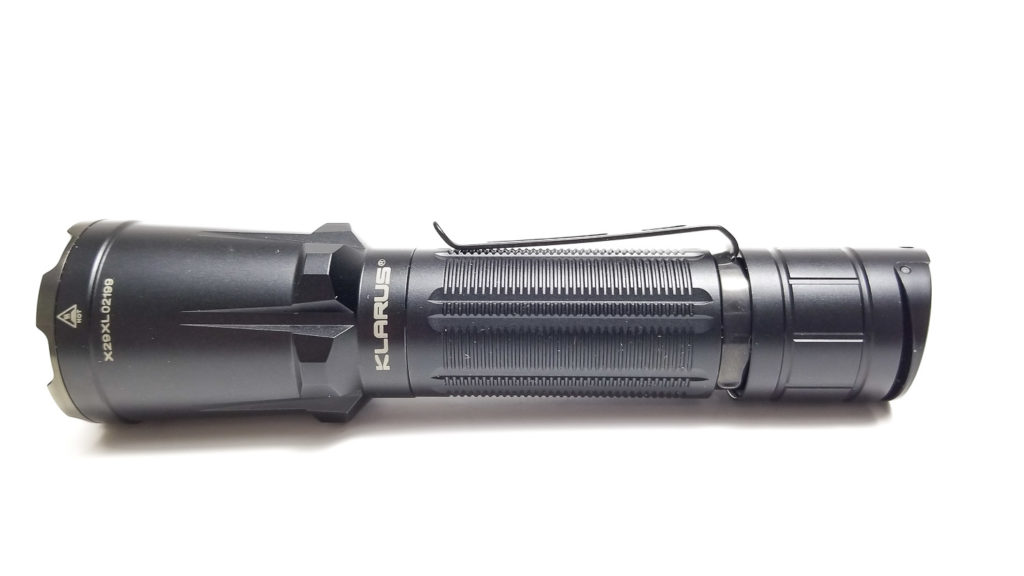
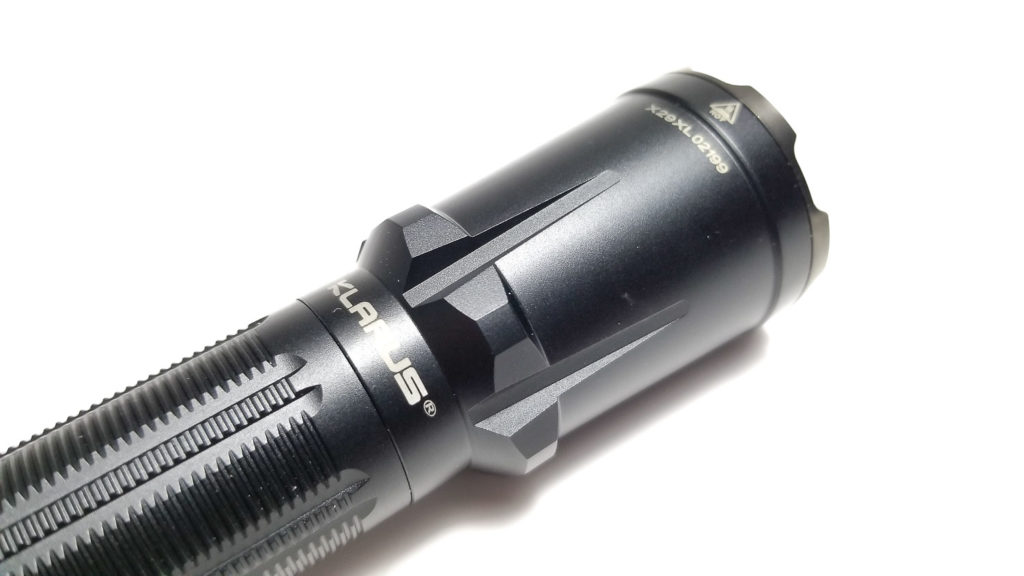
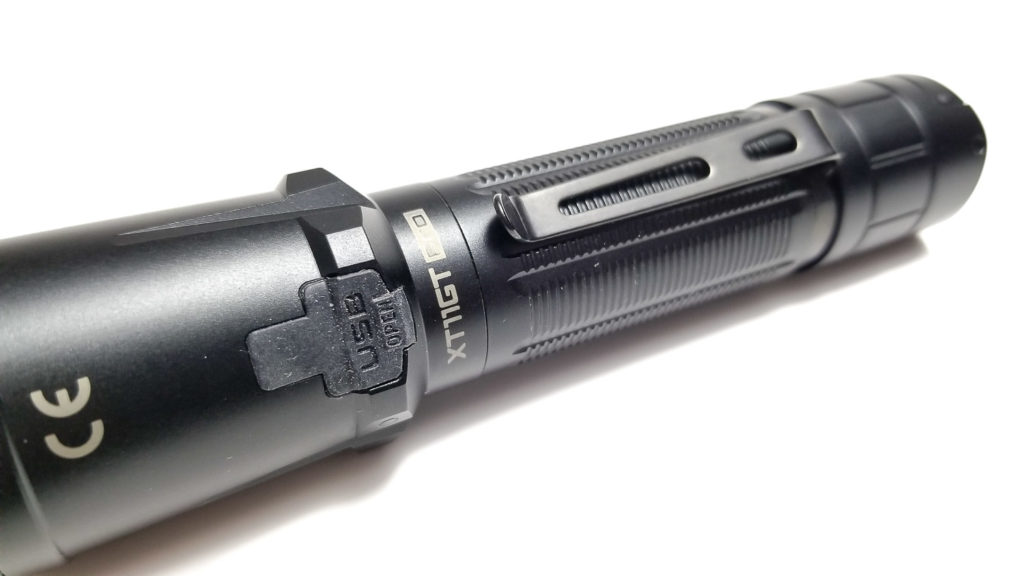
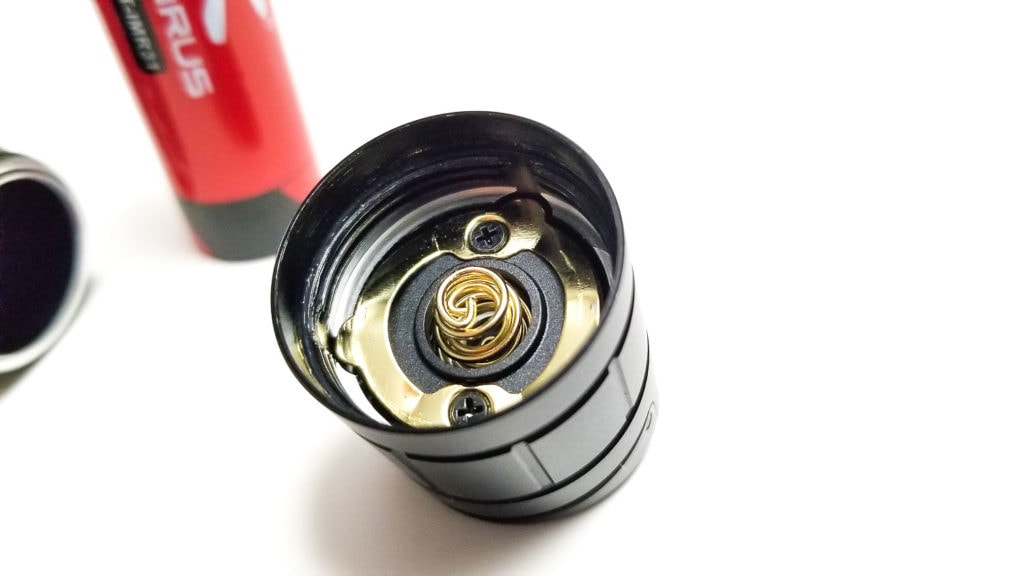
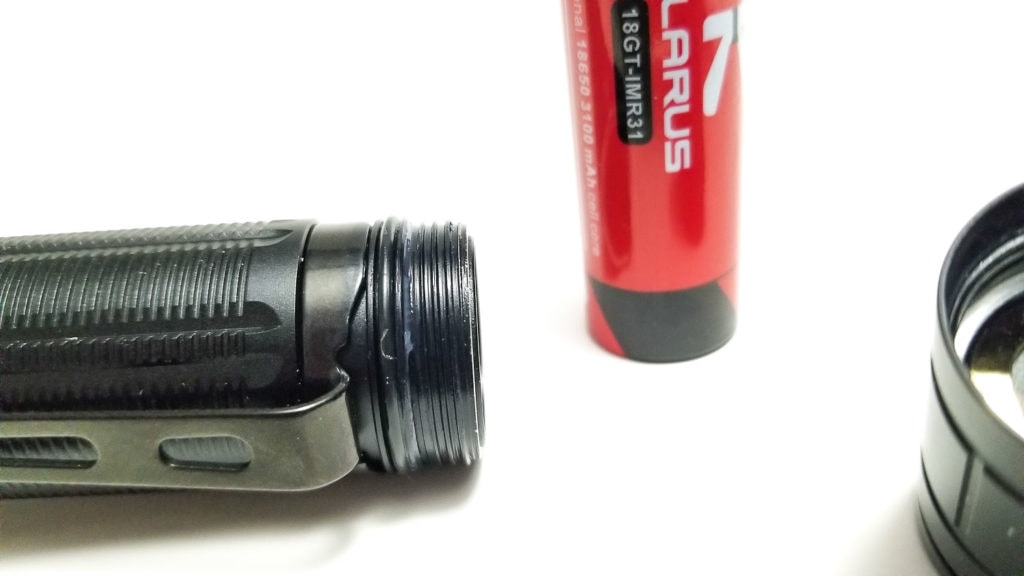

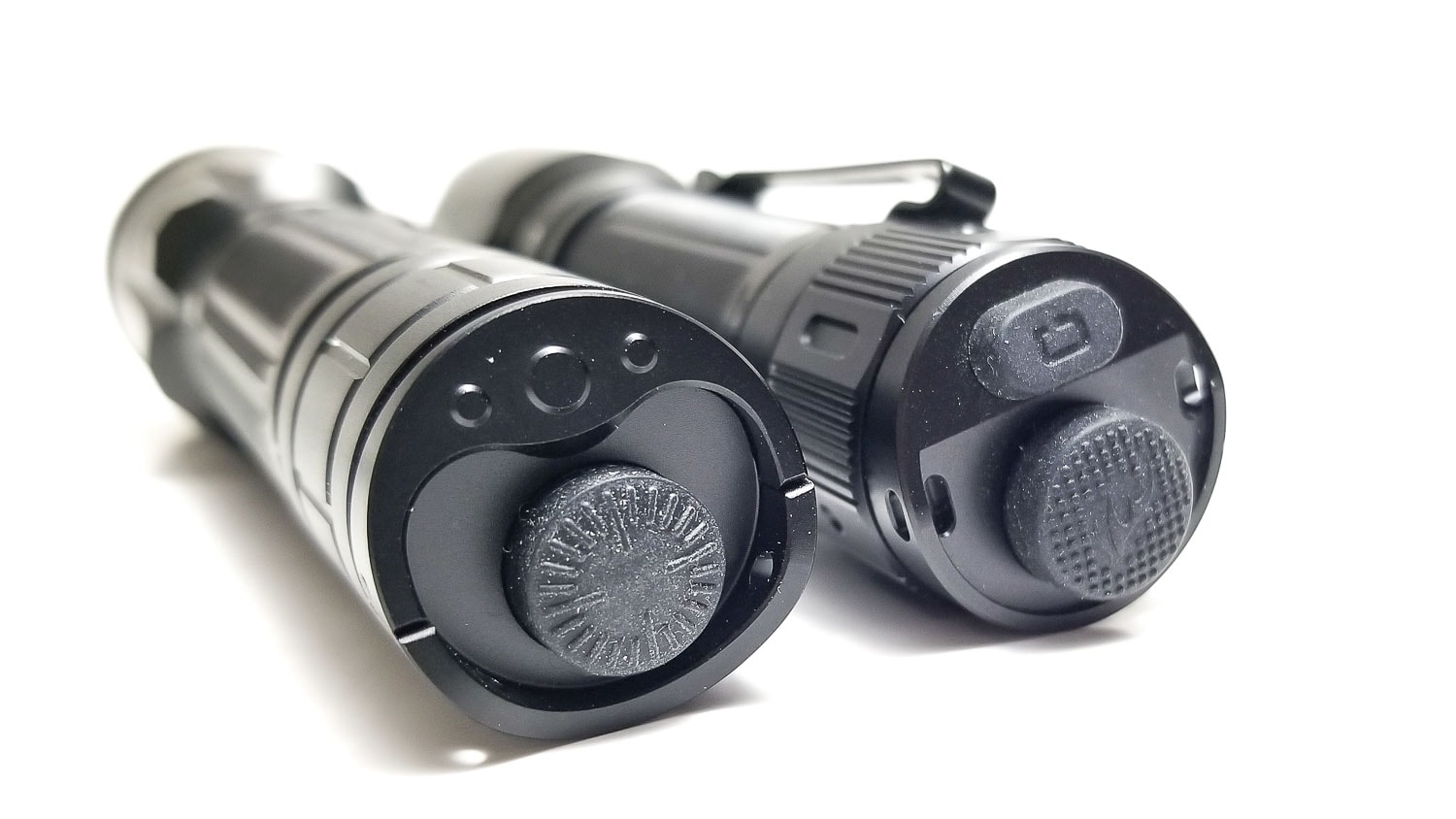
LED, Lens, Bezel, Beam, and Reflector
The first XT11 GT Pro came equipped with the Cree XHP35 HD with 2000 Lumens, and that’s nothing to thumb your nose at, but alas, Lumens sell. Keeping up with the competition usually means enlisting a Cree XHP50.2 or Luminus SST70. I’m pleased to report that Klarus went with the SST70. This is a quad-die domed LED running on 6 or 12 volts (depending on the MCPCB) like the XHP50.2, but the SST70 employs a more traditional bond wire design. The beam will be a lot nicer in an SMO reflector with minimal tint shift or chromatic aberrations. The higher forward voltage means it needs lower current to achieve the same output as the 50.2, but necessitates the use of series cells or a boost driver. It fits the same 5050 footprint as the XHP50.2, but has a slightly smaller LES (about 55% smaller), so you get higher cd/mm2 for an increased throw. It comes in any tint you want as long as it’s cool white (what else?), and with the SST70, you either get a good bin that’s less green, or one that’s more green. I think I got a good one this time. In High mode, the Opple Lightmaster 3 puts the CCT around 6000K and the CRI a low 65. Duv is a pretty acceptable 0.0081. I have several lights with the SST70 and although it’s not an apples-to-apples comparison due to differences in drive current, on the High mode (or equivalent), the Fenix PD36 Tac came in at 0.0105, Fenix TK16 V2 0.0133, and Thrunite BSS V4 0.0112. The greenest one? The Imalent R30C 0.0176.
The reflector is a deep, flawless SMO unit. It’s a little larger than the Fenix TK16 V2.0 and smaller than a C8 reflector. The bezel is an aggressively-crenulated gunmetal PVD coated stainless steel unit (yep, definitely a strike bezel), and the lens is toughened mineral glass with a very nice unobtrusive AR coating. The lens is set back about 5 mm from the edge of the bezel and should protect the lens during drops (or breaking glass). The beam is very nice, artifact-free, and the tint is surprisingly nice. I was expecting green at low power and blue-white at higher settings, but I was pleasantly surprised by the even tint distribution. The beam consists of a focused (large) hotspot surrounded by a narrow spill pattern. It’s about the same as the Fenix TK16 V2, so there’s more than enough throw for general purpose use, and it’s about perfect for tactical or duty use. The Strobe setting is properly dazzling, and Turbo is blinding.
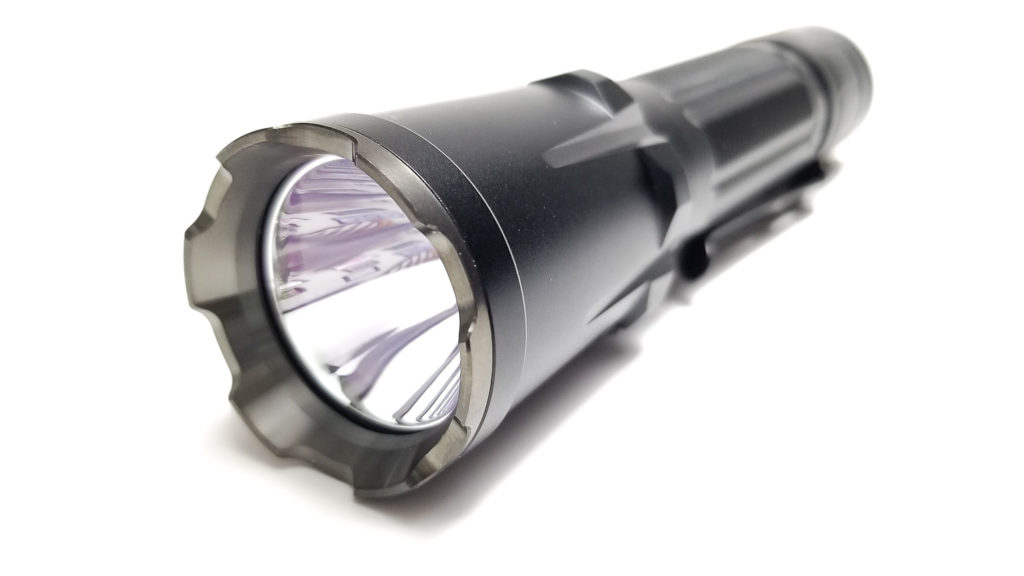
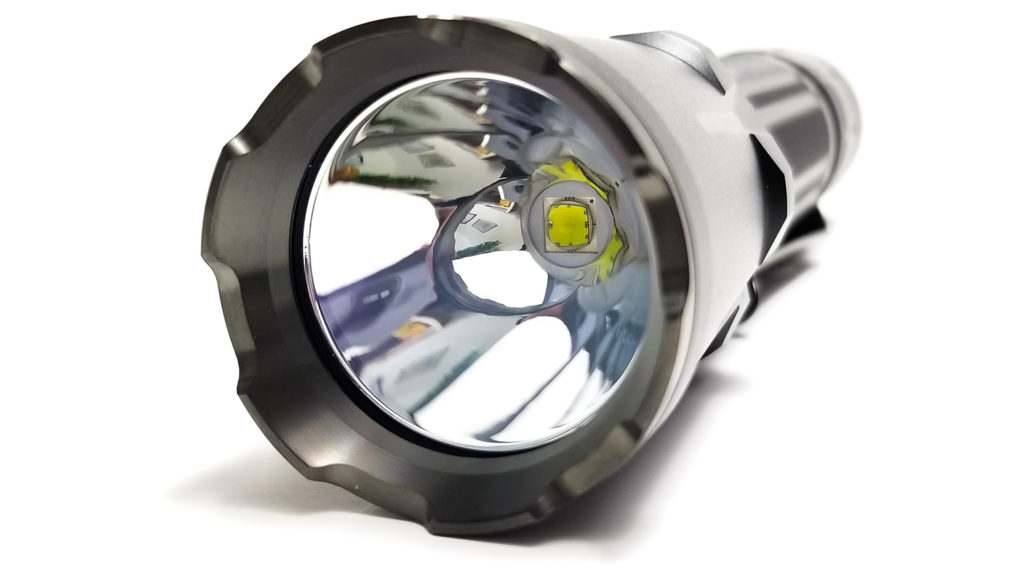

Dimensions and size comparison
- Length: 13.97 cm / 5.5 inches
- Head diameter: 3.5 cm / 1.35 inches
- Body diameter: 2.5 cm / 1 inch
Weight:
- With included battery: 172.9 grams / 6.09 oz.
- Without battery: 124 grams / 4.37 oz.
Tactical Flashlight comparison
I compared the XT11GT Pro V2 to some other 18650 and 21700 size tactical/duty tube lights.
Group 1 left to right: Tactical flashlights: Thrunite BSS V4, Fenix PD36 Tac, Klarus XT11GT Pro V2, Fenix TK16 V2, Fenix PD35 v3.
Group 2 left to right: Speras E3, Acebeam L17, Klarus XT11GT Pro V2, Thorfire C8.
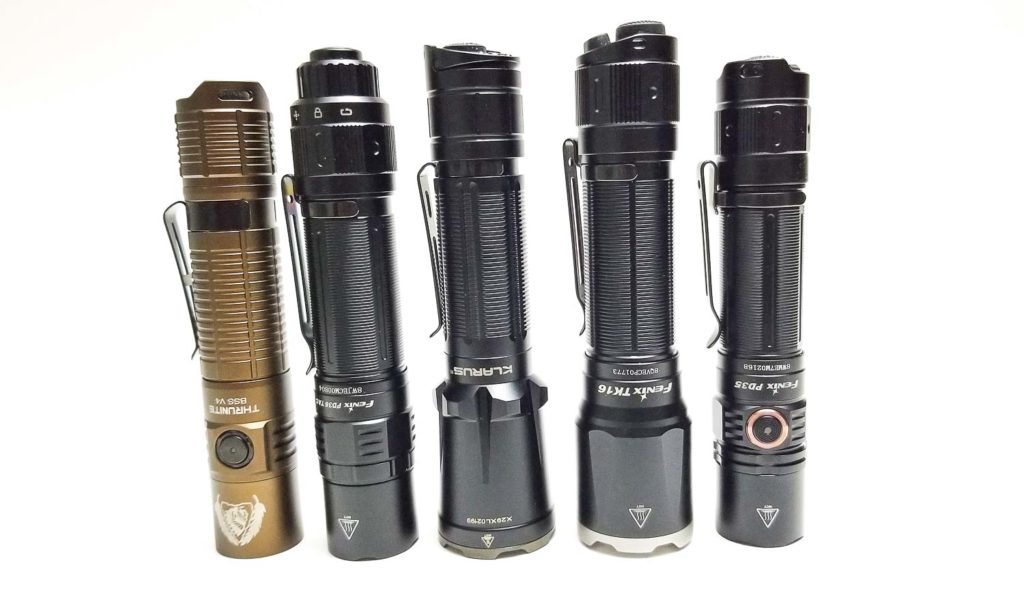
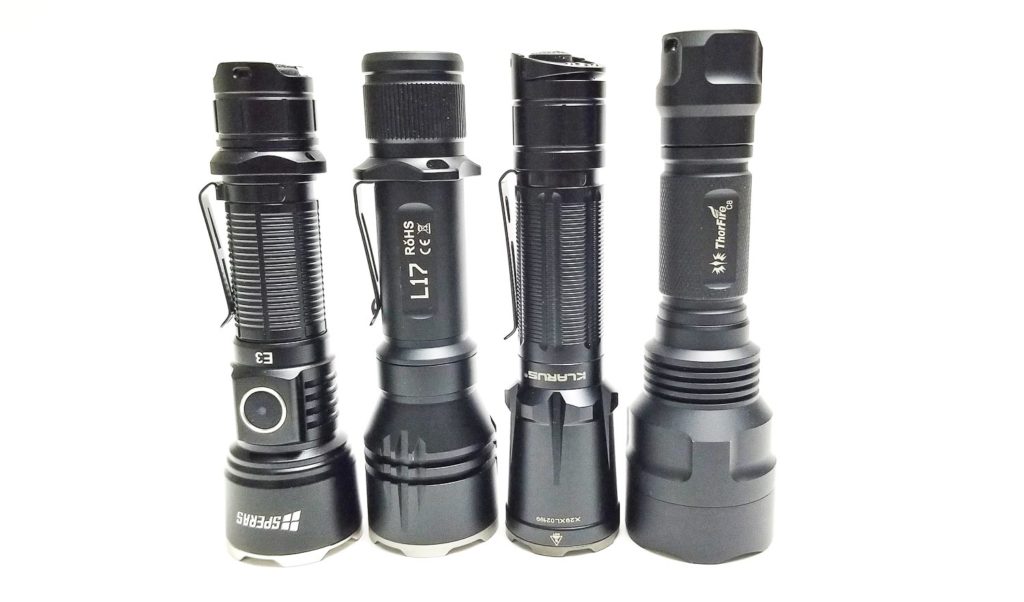
Driver & User Interface:
This is one area where the tactical posers are separated from true tactical lights and enthusiast-grade lights. Professional-use lights usually have constant-current drivers that are fully regulated boost or buck drivers. These are superior to FET-based drivers in that they produce consistent brightness throughout the battery’s usable capacity. The XT11GT Pro V2 is probably utilizing a buck driver since it can run on 4.2 or 6 volts.
I am expecting a simple-to-use and intuitive UI, and that’s what you get. Although Anduril and other enthusiast UIs are great, there’s no place for them on professional-use lights where superfluous features and unnecessary functionality just get in the way. Case in point: Ever see a cop toting around a FW3A or KR1? I haven’t.
The UI is super-simple, but extremely functional and consists of 2 user-set modes: Tactical and Outdoor. Tactical is geared more towards, well, tactical use, and Outdoor is more for duty or general purpose use and each has some minor differences. Tactical mode is enabled by default, but can be easily switched to Outdoor mode with some button presses. Thankfully, it doesn’t require tirelessly pouring over the manual or taking a night class at the community college to figure it out. Switching from Tactical mode to Outdoor mode is easy: Press and hold the mode switch until the indicator LED turns red then flashes green. While still holding the mode switch, fully click the main switch. Done! To change back, repeat the process.
Available modes: Low, Medium, High, Turbo, Strobe, *SOS
From OFF (Tactical Mode):
- Half-press/tap main switch: Momentary Turbo
- Fully click main switch: Continuous Turbo
- Tap mode switch: Momentary Strobe
- Press and hold mode switch: Continuous Strobe
From OFF (Outdoor Mode):
- Tap main switch: Momentary on in last mode (or Low)
- Full press Main switch: Continuous on
- Tap mode switch: Momentary Low
- Press and hold mode switch: Turns on in Low. Pressing for an additional 2 seconds then tapping the switch will switch modes L-M-H-T
From ON (Tactical Mode):
- Tap main switch: N/A
- Fully click main switch: Turns off
- Tap mode switch: Momentary Strobe
- Tap mode switch with main switch clicked: Change modes T-H-M-L-T
- Press and hold mode switch: Continuous Strobe
From ON (Outdoor Mode):
- Tap main switch: Turns off
- Full click main switch: Selects current mode
- Click mode switch: Changes modes L-M-H-T-L
- Press and hold mode switch: Continuous on. Holding the switch for more than 2 seconds after the mode is chosen will turn the light off.
Mode memory:
- Yes, but only in Outdoor mode. No mode memory in Tactical mode. Turbo is memorized!
Shortcuts:
- When in Tactical mode with the main switch fully depressed, pressing and holding the mode switch for 1 second activates momentary strobe. Releasing the mode switch will default to Turbo. In Outdoor mode, momentary operation is available by tapping the mode switch once a mode is selected after turn on.
Low voltage warning:
- The LED indicator will show battery state when turned on: Solid green for 100-70%, orange 70-30%, solid red less than 30%, flashing red, less than 10% remaining.
Strobe/blinkies
- Single strobe and SOS. SOS is accessed in Outdoor mode by clicking on the main switch and holding the mode button for 3 seconds.
Lock-out mode:
- The light can be locked out by unscrewing the tailcap ⅛ turn.
PWM
- None!
Additional info on the UI: First off, Klarus has whipped up a fantastic UI for both duty and pure tactical use, albeit with some quirks and redundancies. Outdoor mode is more suited to everyday tasks and Tactical mode is for, well, tactical applications. Tactical mode has all the mandatory features a tactical light should have: No electronic lockout, no mode memory, instant Turbo, and instant Strobe, with Turbo being the default mode. Even when switching modes in Tactical mode, you always end up at Turbo at .
What’s the difference between Klarus Tactical mode and Outdoor mode set?
Tactical mode always starts in Turbo when using the main switch, and instant Strobe when using the mode switch. In Outdoor mode, mode memory is enabled, and the light starts in the last mode selected with the mode switch, e.g. mode switch in Medium, clicking the main switch off, then clicking the main switch again will start in that mode with either momentary or continuous operation. Some other nice and somewhat quirky features of Outdoor mode are that both switches can turn the light on or off, but only the mode switch will switch modes. Also, if using the mode switch to turn the light on or off in Outdoor mode, it always starts in Low with no memory. Memory is only available if the light was turned on with the main switch. I was super-excited to see momentary mode available on both Tactical and Outdoor modes, something I haven’t come across in a non-Anduril UI before. Overall, this is an excellent execution of a dual-purpose UI and it makes fantastic use of the dual-switch layout. Klarus says there’s ATR available, but runtime testing will tell.
Batteries & Charging
The Klarus XT11GT Pro V2 takes an 18650 size battery, and Klarus bundles the light with their 18GT-IMR31 cell, a button top 3100 mAh protected 18650. I don’t know what’s under the wrapper, but it seems like a good quality battery with a gold-plated button top, and Klarus warranties it for 1 year. Nice. It’s not proprietary either, and at about 4 mm longer than a standard 18650 it would fit any light where a button top would fit. You can also charge it in any li-ion charger (provided it fits). Klarus says the XT11GT Pro V2 can take 2x CR123A cells, so I got some to try. Unfortunately, the Energizer CR123As I got did not work, and no surprise because at 16 mm wide and about 34 mm long, they are too loose in the tube and too short to make reliable contact with both springs. Maybe another brand would? Even so, I’m fine with 18650s and I’m sure most everyone else would be also. I also tried some unprotected flat top 18650s, but even the Sanyo 18650GA with their elevated positive contacts didn’t fit. However, unprotected button tops fit fine.
Like most modern lights, you get onboard charging with the XT11GT Pro V2. Onboard charging is becoming mandatory on consumer lights, and I think it’s a great feature for convenience. The light recharges via USB type C and Klarus says it’s good for 1 amp maximum charge rate. I saw 1.08 amps on my USB tester, which should charge the battery in a leisurely 3 hours or so. USB C to C cable did not work. The charge indicator LED is red while charging and turns green when charged. The battery charged to 4.18 volts.
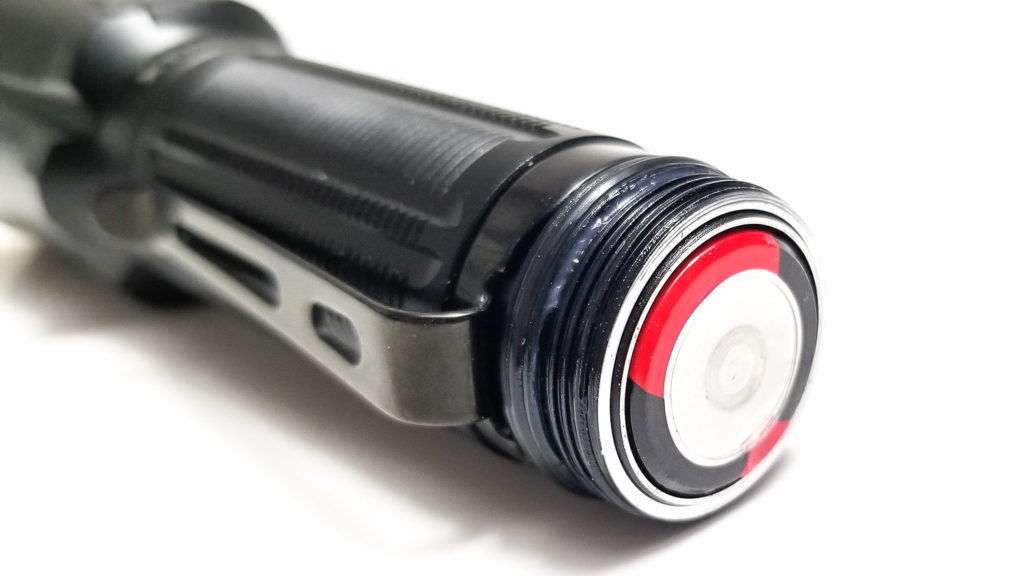
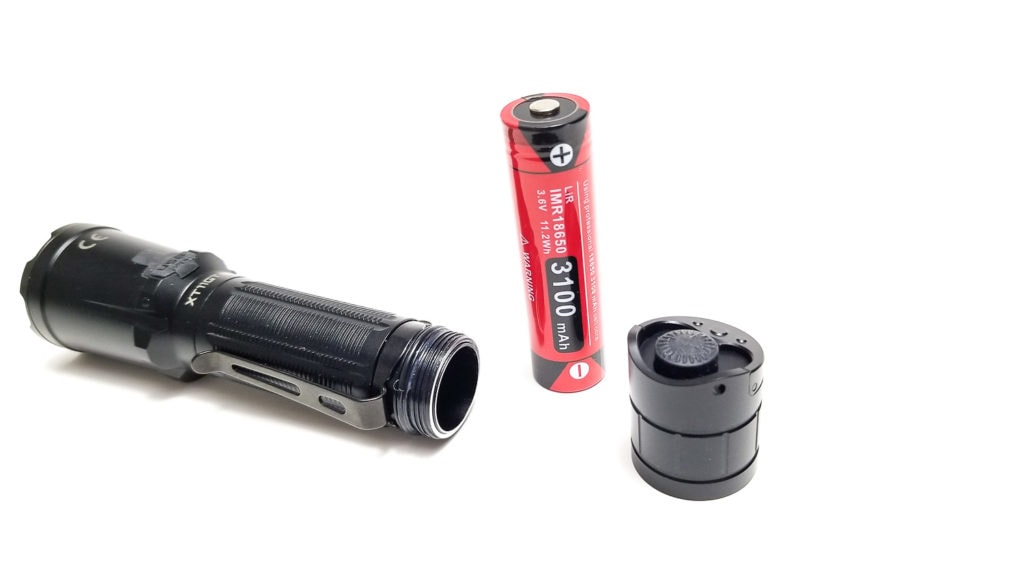
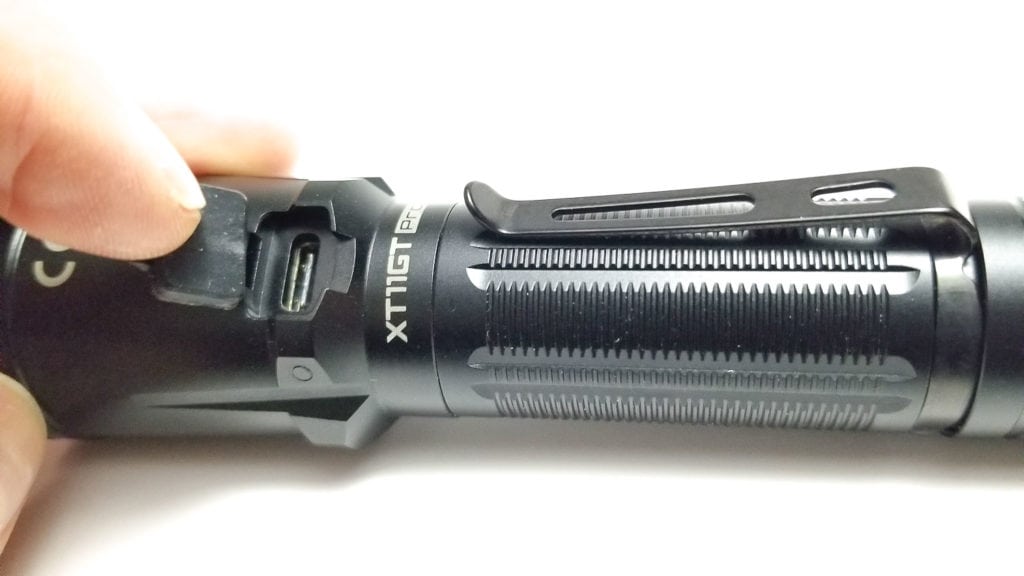
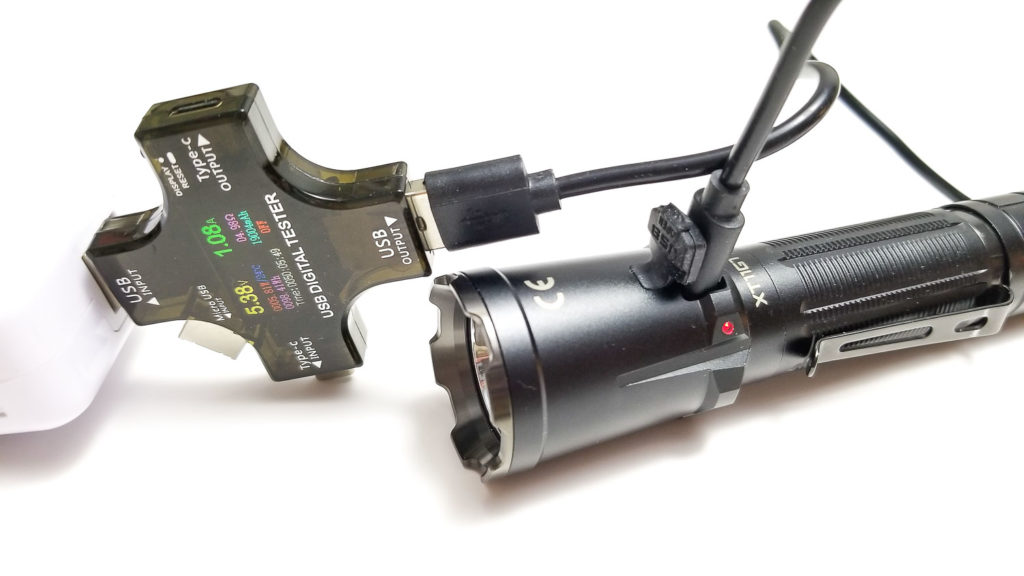
Performance
Lumen measurements:
Lumens were measured using my home made 30 cm integrating sphere that’s been calibrated with several lights of known output including a Makkua-calibrated Convoy S2+. I use a Digi-Sense 20250-00 datalogging luxmeter. I used the included, fully charged, Klarus 18GT-IMR31 cell. I measure current with either my RadioShack T-RMS multimeter with 16 gauge wires directly in the meter for under 8 amps, and my clamp meter with a 12 gauge wire loop for anything more. Unfortunately, I gave up trying to measure the current since I was shorting things and didn’t want it to release the magic smoke.
| Mode | Specs | turn on | 30 sec | 10 min |
|---|---|---|---|---|
| Low | 10 | 6.64 | 6.6 | – |
| Medium | 200 | 235 | 234 | 233 |
| High | 1200 | 1170 | 1162 | 589 |
| Turbo | 3300 | 2781 | 2299 lm | 996 |
This is pretty impressive output, and it’s about the same as the SST70 offerings from Fenix (PD36 Tac and TK16 V2).
Parasitic drain:
- (switch LED off) 2.2 µA
Runtime graph
I conducted the runtime testing using my home made 30 cm integrating sphere, calibrated with many lights of known output including a Makka-calibrated Convoy S2+ with a Digi-Sense 20250-00 datalogging luxmeter. I used the included fully charged battery and tested Medium, High, and Turbo modes.
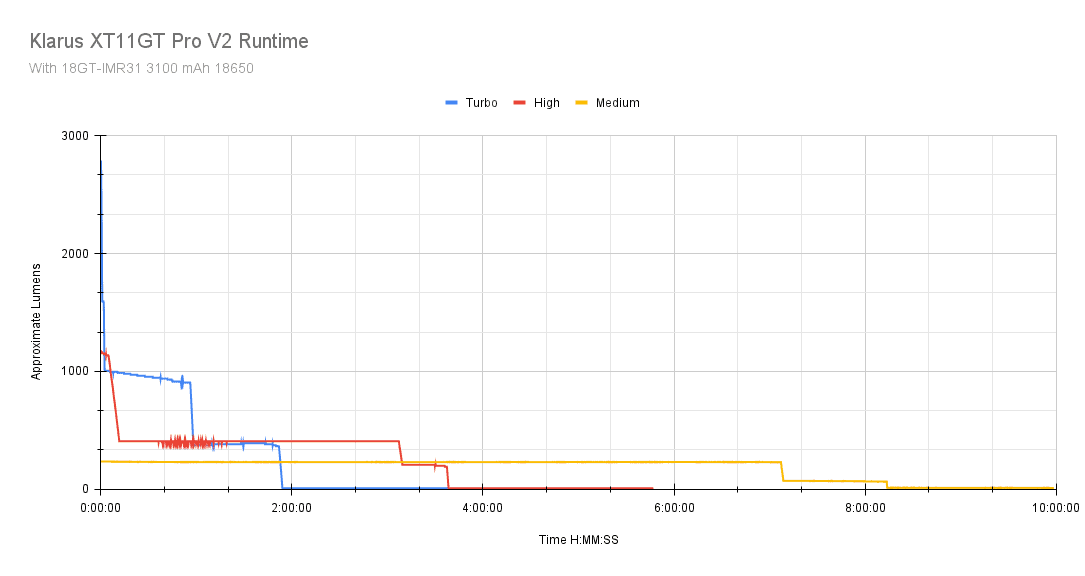
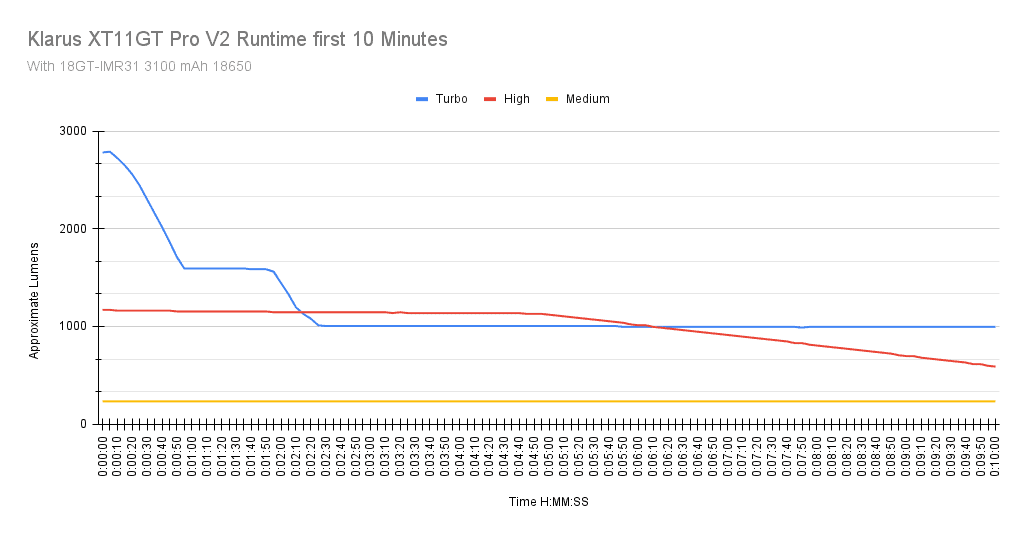
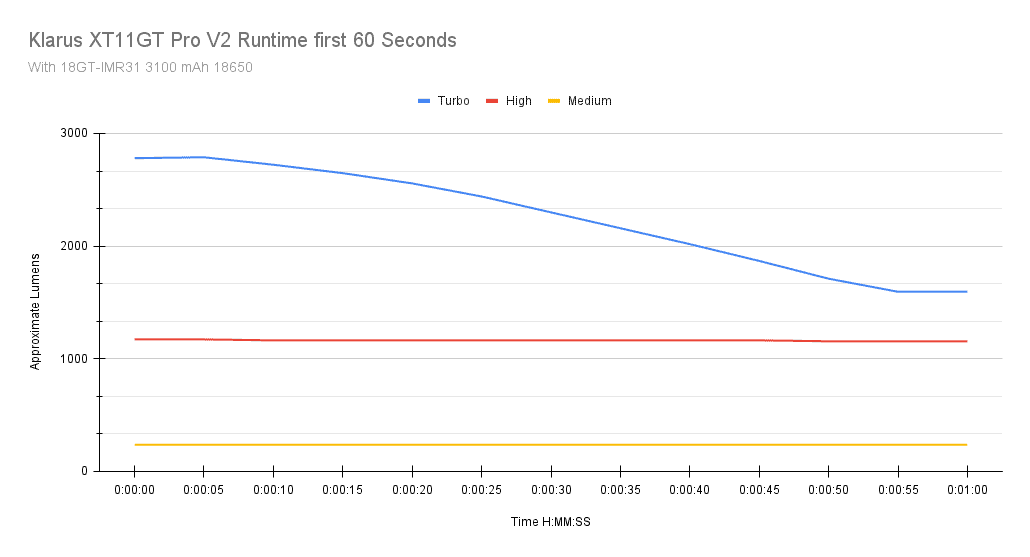
Turbo started at a little over 2780.5 Lumens and actually rose a little after the start to a peak of 2788 before stepping down gradually in stages. The output was over 2000 Lumens for almost 50 seconds, which is pretty good, and held 1500 Lumens or better for almost 2 minutes, and 1000+ Lumens for almost 6 minutes. The output settled at between 996 and 900 Lumens for almost an hour, but at the 56 minute mark the stepdowns started as the driver pulled the output down to about 390 Lumens, which it held for another 54 minutes before LVP kicked in and dropped the output to about 9 Lumens. The light shut down at 4 hours 3 minutes, and that’s quite a bit longer than Klarus specs at 1 hour 48 minutes, which is pretty close to the 1 hour 52 minute final step down. Temps were very reasonable, peaking at 55 C at the 15 minute mark, and the light was still bare-handable the whole test, with the tube only getting to 46 C. The battery was discharged to 2.76 volts.
High started at a bit over 1100 Lumens, and held over 1000 Lumens for about 6 minutes, which is pretty good for a light with limited heatsinking. Temps were also reasonable, never getting over 40 C. After the last step down from 1000 Lumens, the output settled at 400 or so Lumens for a long, long time: From 11 minutes 35 seconds to 3 hours 7 seconds until a gradual drop to 207 Lumens, then 199, before LVP drops the output to the same-as-Turbo 9 Lumens until shut down at 5 hours 46 minutes. Klarus specs 4 hours for this runtime, and that’s in line with the final step down at the 3 hour 38 minute mark.
Medium was the longest runner here, starting at 239 Lumens, and staying a rock-steady 229 Lumens for 7 hours 7 minutes until stepping down to 70 Lumens until a steep drop at 9 hours 51 minutes, and shutdown 7 minutes later at 9 hours 58 minutes. Klarus specs 12 hours for this runtime at 200 Lumens max. Temperatures were barely above ambient.
This is typical performance from a well-regulated buck driver, and very decent performance from the XT11GT. The driver is well-matched to the SST70, and the ITC manages the heat very well. The runtime profiles are similar to the Fenix TK16 V2, and perfect for duty work, traffic control, and long night shifts where long, fully-regulated brightness is mandatory. There’s evidence of a protection circuit in the battery because the light would not turn on after the tests until charged.
Throw numbers:
I measured the throw with the Uni-T UT383S luxmeter indoors at 5 meters. I used the fully charged included battery for the test. Readings are recorded at 30 seconds.
| Mode | Specs | Candela measured | Meters | Yards |
|---|---|---|---|---|
| Low | 64 cd | 100 cd | 20 | 22 |
| Medium | 1940 cd | 3100 cd | 111 | 122 |
| High | 10,400 cd | 16,700 cd | 258 | 283 |
| Turbo | 29,440 cd | 33,150 cd | 364 | 398 |
| Turbo at turn on* | – | 43,200 cd* | 416 | 455 |
A word about Klarus’ specs for throw: The 29,440 cd figure doesn’t calculate to 410 meters like the website says. At the 30 second mark, I’m doing better than that at 364 meters. At turn-on, I got 415 meters, which is about the same as the Fenix TK16 V2. This is pretty decent throw for a sub-40 mm reflector!
Beamshots
Throwers:
I compared the XT11GT Pro V2 with some similar lights:
Thrunite BSS V4 (SST70 2500 Lumens), Fenix PD36 Tac (SST70, 3000 Lumens), a C8 with XHP50.2 (about 3200 Lumens), Fenix TK16 V2 (SST70, 3100 Lumens), Thrunite TC15 V3 (XHP35.2 HD, 2400 Lumens), Olight Odin (TIR 2000 Lumens), Sofirn SC31T (SST40, 2000 Lumens), Wuben C2 (SST40, 2000 Lumens)
Outdoor pictures: The fence is about 95 meters distant.









Disclaimer: This flashlight was sent to me for review at no cost by Klarus. I have not been paid to review, nor have I been holding back on problems or defects.
Final Verdict
Pros
- Great build quality
- Very high output
- Nice warranty
- Non-proprietary battery
- Awesome tactical/general purpose UI
- Intuitive switch layout
- Well-regulated driver
- Doesn’t get very hot
Cons
- CR123As and standard 18650s did not work
- Only one O-ring?
- Tiny lanyard hole
- Stiff mode switch
Explanation on star ratings:
1: Avoid: my phone flashlight would be a better choice – 2: Poor: significant defect or issues; almost unusable – 3: Average: some defects or issues; but still usable 4: Good: recommended (minor issues) – 5: Great: highly recommended

5 stars: ★★★★★
It’s surprising that I hadn’t heard much of Klarus before this review, and honestly, when I was asked to review another tactical light, I was thinking, “Not another one!” but this may be the best kept secret in the professional flashlight market, and this market segment is highly competitive with tons of solid tactical and duty lights. I’ve reviewed quite a few flashlights, and among those, I’ve tested some of the better tactical/duty lights on the market, so I have a pretty good idea of what makes a “good” tactical/duty light, and no, those 9,000,000 Lumen, 3 AAA zoomies you get on Amazon are NOT tactical lights.
A tactical light has special features that separate it from a general purpose light, including a simple UI, mechanical or electronic (or both) switches, instant access to Strobe and Turbo, heavy-duty features like dual springs, strike bezels, and the ability to be mounted to a long gun (rifle) with remote switches. The Klarus XT11GT Pro V2 is a great tactical light with an impressive pedigree to go with great performance and a robust feature-set catering to duty and tactical users.
It’s a very well-made light capable of very high output, has a really nice beam profile and decent tint for an SST70. The UI is easy to learn and well-suited to both tactical and duty use as well thanks to the Outdoor mode. You get good runtimes with the 18650 cell as well with consistent output. However, no light is perfect, and the XT11GT misses on a couple key areas. If you require your tactical light to use CR123A’s, you might consider another light or at least try to find larger CR123A’s. The mode switch is a bit stiff, and some might be put off by it, but that’s actually a benefit since it’s exposed and can be accidentally activated. I couldn’t get the lanyard in the holes either, and only one o-ring on a $90 light? C’mon Klarus.
Overall, I think I may have stumbled upon the proverbial unicorn tactical flashlight. The XT11GT Pro V2 checks off a lot of boxes, and just does a lot very well. At $90, it’s not cheap, but worth every penny. Although there’s a great selection of lights to choose from in the tactical/duty segment, if you can go without CR123A compatibility, give the XT11GT Pro V2 a close look. 5 stars for the Klarus.
Klarus XT11GT Pro 2 for sale:
1lumen selects and reviews products personally. We may earn affiliate commissions through our links, which help support our testing.